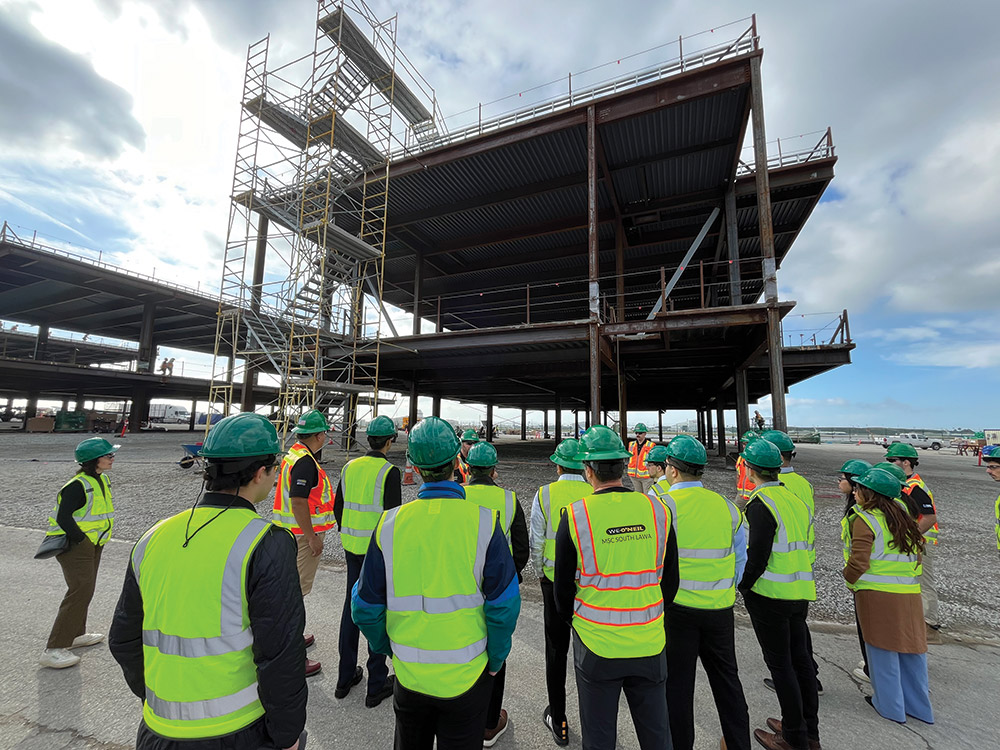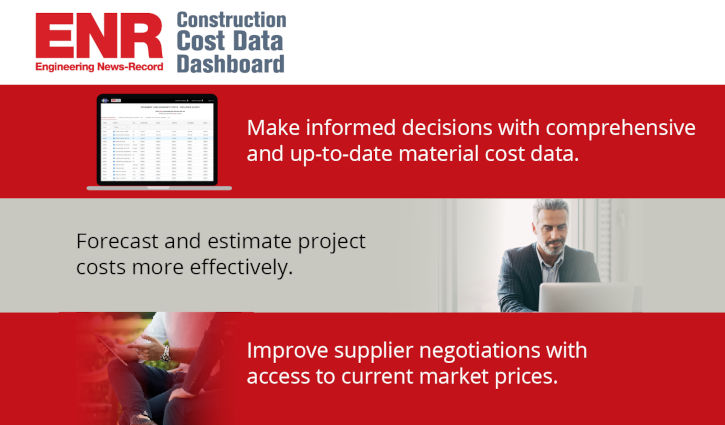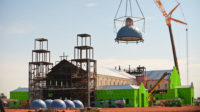ENR Top Project Delivery Firms: Firms Say Early Collaboration Makes Gains
June 12, 2024
ENR Top Project Delivery Firms: Firms Say Early Collaboration Makes Gains
June 12, 2024Garney is installing 24,400 linear-ft of sewer force main from Boat Harbor Pump Station to the Nansemond Treatment Plant in Virginia.
Photo courtesy of Garney Construction
Related Links:
ENR Top 100 Design-Build Firms 2024
ENR Top 100 Construction Management-at-Risk Firms 2024
View complete 2024 list, with full market analysis
(Subscription Reguired)
Comments from this year’s Top 100 Project Delivery Firms reveal that supply chain delays, inflation and limited labor resources remain key challenges in delivering projects on time and under budget. Yet rather than focusing on a particular project delivery method, firms say more owners are asking for collaboration early on to proactively control construction costs and prioritize flexibility.
Overall, revenue for both design-build and construction management-at-risk (CMAR) delivery methods rose last year—with design-build increasing 26.1% to $137.19 billion and CMAR increasing 8.56% to $173.97 billion.
Median design-build revenue is up 27.1% over last year, rising to $754.3 million from $593.35 million, whereas the median CMAR revenue increased 3.3%, to $963.88 million from $933.04 million. Of the 93 top design-build firms that filed this year and last, 77.4% reported more design-build revenue this year, and 78.8% of top CMAR firms reported more CMAR revenue this year.
Revenue numbers for Top 100 design-build and CMAR firms also reflect what firms say has been an industry-wide shift toward more collaboration to navigate increasingly complex market challenges that have intensified since the start of the COVID-19 pandemic.
“Inflation and supply chain disruptions resulting from the pandemic have sparked a positive trend toward increased scheduling flexibility and project modification,” says Garney CEO David Burkhart. “This shift toward prioritizing the budget over the schedule reflects proactive cost management measures.”
Embracing Flexibility
At Clayco, effective risk management requires project owners who are willing to think outside the box, says Anthony Johnson, executive vice president and president of the firm’s Industrial Business Unit.
“We have always looked for clients willing to find a better way (than) design-bid-build delivery,” says Johnson. “Today, more customers are searching for ways to engage with their integrated design, engineering, and construction teams earlier in the process.”
The design-build project delivery method has an inherent advantage when it comes to engaging project stakeholders early on, says Gray Construction President and CEO Brian Jones.
Jones says the firm sees the industry’s shift toward earlier collaboration as a “clear acknowledgement that early engagement with an industry expert on design-build delivery is key to meeting critical project milestones and going to market ahead of competitors.” He adds, “Design-build’s relevance in the modern market and inherent advantages explain owners’ willingness to deviate from design-bid-build.”

“Design-build’s relevance … and inherent advantages explain owners’ willingness to deviate from
design-bid-build.”
Brian Jones, President and CEO, Gray Construction
Although Swinerton’s director of preconstruction and estimating, Daniel Getting, says the firm has seen a “significant uptick” in design-build project procurement, “specifically, progressive design-build,” there is still a “strong appetite for CM-at-Risk.”
Getting explains, “We see more of a shift in market types, temporarily away from hospitality and market-rate residential projects until capital markets improve.”
For owners that know what they want and have the resources to manage design and schedules, CMAR continues to be a preferred delivery method for private and institutional clients building research labs, medical and general office space and hospitality projects, says DPR CEO George Pfeffer.
“The owner profile for CM-at-Risk has not changed dramatically,” says Pfeffer. “However, as customers take on larger, more complex, tight-timeline projects, they tend to shift toward collaborative versions of CM-at-Risk or progressive design build.”
Managing Risks
At the center of every project is risk, and how a particular project delivery model is able to manage such risks is a major determinant of success for many Top 100 firms. For projects using the CMAR project delivery model, preconstruction services can improve design and weed out any potential scheduling challenges.
At Gilbane, such services include virtual design and construction (VDC) and lean techniques, as well as a proprietary document coordination system, says President and CEO Adam Jelen.
“During preconstruction, our supply chain team further informs our team of scheduling challenges and material constraints and provides that path to direct procurement, purchasing materials directly through our national vendors,” says Jelen.
Winning work is a “two-way street” for delivery firms and their clients, says Barton Malow Holdings COO Chuck Binkowski.
“We must ensure that we are collaborating with the right partners,” says Binkowski. “This involves signing the appropriate contracts and thoroughly understanding what we’re committing to, ensuring that we collaborate with compatible and trustworthy partners.”
For Garney’s CMAR projects, the firm’s strategy for mitigating risk also focuses on selecting compatible owners, says CEO Burkhart.
“This initial step is vital for minimizing project delivery and performance risks,” he says. “With the industry backlog growing, there’s a heightened emphasis on ensuring timely delivery of designated project components from subcontractors and suppliers.”
As part of the design-build delivery model, the qualifications-based selection of partners has enabled Primus Builders to bring reduce risk, says Chief Financial Officer Matthew Hott. “We are able to gain insight into all project stakeholders, which gives our teams the ability to develop an overall project risk profile,” he adds. “As a result, there is an acute awareness of where to focus their attention to mitigate risk during different phases of the project.”
Airports | By Jonathan Keller

Photo courtesy of W.E. O’Neil Construction
In October, W.E. O’Neil Construction (No. 67) and team will realize years of meticulous preparation as nine building segments are carefully rolled into place to form a new concourse at LAX. The segments, which average 80 ft x 110 ft x 40 ft, will be nearly fully built when moved into place. “Our approach has been everything but the furniture,” says Brian Rush, vice president of preconstruction at W.E. O’Neil. The largest segment will weigh around 1,000 tons.
The Midfield Satellite Concourse South project is being delivered using an unusual Offsite Construction and Relocation technique, a first of its kind at LAX. The OCR technique was chosen to minimize disruption to airport operations and to meet an accelerated timeline. The schedule savings using OCR are dramatic, Rush notes. A similar strategy, used in 2021 at Dallas-Fort Worth airport, was an inspiration. The project site is what Rush calls an airport island. “Every worker, material, tool or [piece of] equipment has to cross several runways just to get to the site,” he says. “That was the challenge: how do you build more off-site and less on-site?”
The project team pulled in the security fence on the north side of the airport to create a landside factory to build the concourse segments. In order to make space for the factory, the project team had to clear 180,000 yards of dirt. Locating the construction yard landside saves some logistical time. “There’s no badges: all the workers can pull right up to the job site like they would at any other in LA,” says Rush. It also opens the door for subcontractors who may be leery of doing an airport job, he adds.
Lying between the construction yard and future concourse is the argo ditch—an approximately 80-ft wide x 20-ft deep drainage channel that drains the north side of the airport as well as some of the surrounding community. To build a land bridge over it, the project team had to coordinate with multiple federal, state and airport stakeholders. “It’s been a year and a half coordinating,” explains Rush.
A huge challenge on move day will be the anchor bolts. “Normally you stand one column at a time,” explains Rush. “In this case we have 30 or so columns.” Each column has between 10 and 16 anchor bolts, meaning hundreds of precision fits when the structures are put in place. The team performed multiple coordinated surveys to ensure everything lines up.
The team will roll one segment every three days. Lasers will constantly measure the building’s geometry to make sure that it isn’t racking, with motion sensors measuring the building’s movement. Pre- and post-visual inspections will also be conducted. “It should be a smooth ride,” says Rush.
Increasing Alternative Project Delivery
Research by the consulting and investment banking firm FMI predicts that design-build will account for 46% of construction spending by 2026, up from 42% in 2022.
Although stipulations around projects funded by the Infrastructure Investment and Jobs Act and the Chips Act have likely impacted recent project delivery choices, design-build utilization has continued to increase around the country based on demonstrated performance and outcomes, says Design-Build Institute of America CEO Lisa Washington.
Washington cited FMI research that found 77% of respondents reported a good experience with design-build, compared to only 32% for design-bid-build.
“The ability to select the best-fit team with the capabilities and expertise that best align with the project was noted as a key driver of positive experiences with design-build,” says Washington, adding that this is also the reason design-build is often utilized in emergency rebuilding efforts—such as the team assembled to rebuild the Francis Scott Key Bridge in Baltimore after a collapse in March.

“The ability to select the best-fit team ... was noted as a key driver of positive experiences with design-build.”
Lisa Washington, CEO, DBIA
Beyond embracing design build as a delivery model, Washington says owners are also understanding that its success hinges on best practices and techniques.
“Not only are owners looking for qualified teams, but there is also a trend towards becoming a design-build ‘owner of choice,’” she says, a way for owners to obtain certifications that will make them more attractive as partners for firms.
Washington adds that the growth of design-build utilization is also being driven by increased authority for progressive design-build (PDB)—which involves owners deferring the finalized price, schedule and performance commitments until after the selection of the design-build team and project risks are defined.
all, design-build and contract structures under its umbrella are about enhancing collaboration, she says.
“It’s critical that the industry and owners understand that PDB is not a new method, but a procurement approach under the design-build umbrella,” says Washington. “With that, the foundational design-build best practices are critical to PDB success, as well.”

“Owners continue to raise the bar in a good way. They expect more transparency, accuracy and collaboration in all phases of the project. ”
Daniel Getting, Director, Swinerton
Value Proposition
Overall, selecting the right project delivery method is about increasing the value proposition for the owner, say Top 100 firms.
In this area, “owners continue to raise the bar in a good way,” says Swinerton’s Getting. “They expect more transparency, accuracy and collaboration in all phases of the project.”
W.E. O’Neil President Matt Hoster adds that “needle-moving savings can in fact be achieved when the CM is engaged early to help drive the design path and systems selections.”
For Moss, CEO Scott Moss says its clients have become much more open to design assist after seeing its success. “It has become a much more palpable option in the last few years as it helps to engage qualified trade contractors early, which allows their full attention to be focused on contributing to the success of our projects,” says Moss.
DPR’s Pfeffer adds, “There are enough lessons learned from design-build that even customers that do not adopt it are looking to integrate elements of it in delivery.”
In the end, “this can lead to more efficient and effective preconstruction services,” Pfeffer says, and a more effective construction market.











